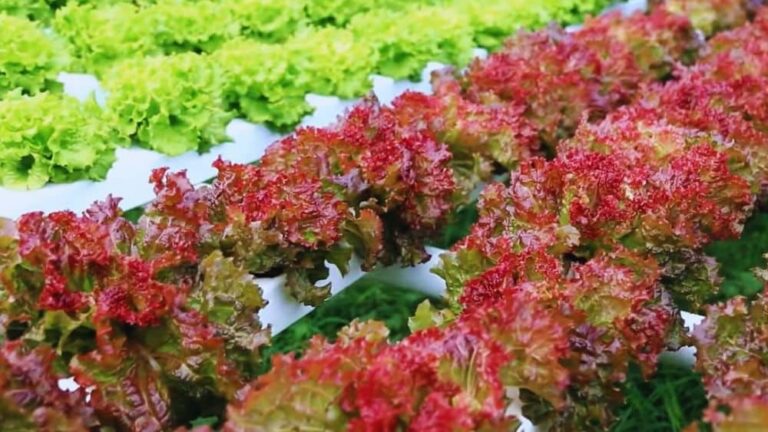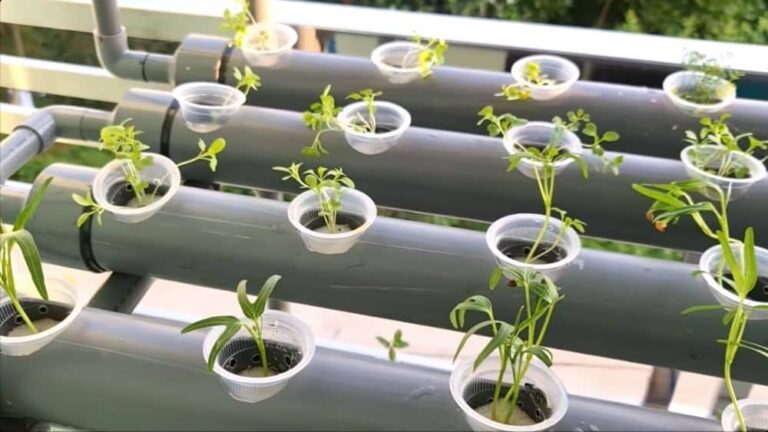Horizontal Hydroponic Systems: A Comprehensive Guide
Green change is now possible thanks to advancements in urban farming and eco-friendly gardening. Particularly, the horizontal hydroponic system is at the forefront of this movement. It is a revolutionary method that lets everyone, from small-scale hobbyists to large-scale growers, make more with less room. By learning how this method works, you can achieve amazing results, even in cities with limited space. This guide provides some useful, professional tips to help you get the most out of your horizontal system. As a result, this approach consistently yields high-quality crops.

The Basics of Your Horizontal Hydroponic Setup
Before optimizing a system, you need to know how it works at its core. The arrangement is what makes a flat hydroponic system different from an upright one. Instead of vertical space, horizontal setups grow plants next to each other on a flat surface. This orientation makes it very popular with growers who have limited vertical room but lots of horizontal space.
The core components of this system include:
Growth Trays: These hold the plants and their growing medium in place.
Nutrient Solution Reservoir: This is a tank where the water mixed with essential plant nutrients is stored.
Delivery System: This involves pumps and tubes that transport the nutrient solution from the reservoir to the plants.
Pick the Right Growth Medium (Tip-1)
The growing medium is critical to the success of this method because it holds the plant roots in place. Since there is no soil, you need an appropriate medium that lets nutrients get to the plants and lets air flow well.
These are some of the most effective mediums:
Coconut Coir: Made from the husk of coconuts, this is a sustainable and efficient medium. It retains moisture well and ensures good oxygenation.
Perlite: Perlite is a light volcanic rock that lets water drain away and airflow through the soil.
Vermiculite: Mixing vermiculite with perlite helps seeds grow because it holds more water.
Rockwool: This medium is made from melted basaltic rock and keeps water in while letting air flow through it.
Choose a medium based on the type of plant you have and what your horizontal system needs. Regularly inspect and replace the medium as necessary to maintain plant health.
Ensure a good light spread (Tip-2)
Different parts of the U.S. have different durations and intensities of daylight, so many indoor growers need artificial lighting. The horizontal plan has its drawbacks, like shadows, if the light isn’t spread equally.
For a successful system:
Pick the Right Light: LED grow lights are suitable for hydroponic systems because they use little energy and can vary in spectrum and strength.
Ensure Uniformity: Adjust light heights and placements so all plants receive even exposure. Rotate plants periodically to balance light distribution.
Monitor Duration: Different plants need different amounts of light. Research the specific needs of your crops and adjust the light duration accordingly.
Proper nutrient delivery (Tip-3)
The nutrition solution is critical for plant health and growth. Here’s how to get the most out of it:
Check the nutrient solution often: Use a TDS (Total Dissolved Solids) meter to find out how concentrated the water is and a pH meter to find out how acidic it is. For most plants, you want 5.5 and 6.5.
Ensure Even Distribution: Install a reliable pump to ensure the nutrient solution is evenly distributed across all plants. Check for blockages or malfunctions regularly.
Change the Solution Regularly: Over time, certain nutrients may be depleted. Refresh your reservoir with a fresh nutrient mix every 2-3 weeks.
Keep an eye on and change pH levels (Tip-4)
Maintaining the appropriate pH level of your nutrient solution is essential for plant health in hydroponics, especially when transferring hydroponic plants to the soil. It directly affects nutrient absorption, influencing crop growth and yield in a horizontal hydroponic system.
The most appropriate pH levels for growth are:
Most plants do best in this hydroponic setup where the pH level is between 5.5 and 6.5. This range ensures critical nutrients are available at the best levels. Plant transplantation into the soil depends heavily on this factor.
Innovative Tools for Precision:
Regular monitoring can prevent pH fluctuations. Easy-to-use digital pH meters or pH indicator solutions offer quick and accurate readings. Investing in reliable tools enhances your capability to respond to pH instability promptly. It is vital for both mature plants and seedlings.
Techniques for pH Adjustment:
If readings indicate an imbalance, pH adjusters can fix it. Add small amounts of pH “up” or “down” solutions to the nutrient mix and keep testing until it reaches the right level. Remember that the most effective way to control pH is to check it often, use accurate tools, and be careful about how you react to imbalances.

Keep up with regular system maintenance (Tip-5)
It takes a lot of work to keep a system running well and grow your plants. Regular upkeep is very critical because it stops algae growth that clogs the system.
Routine Checks and Cleaning:
It is very important to do regular maintenance. First, check it every day and every week. Watch the water level, look for signs that the plants are having trouble, and look over the parts of the system for any signs of damage or wear.
Second, do upkeep once a week by changing the nutrient solution and cleaning the filters and pumps. It keeps the system running smoothly and the plants growing well, which is very important for this system.
Preventive Measures for System Longevity:
To extend your system’s lifespan, flush it monthly with clean, pH-balanced water to prevent salt accumulation. After a while, tubes and other parts that get dirty require replacement or cleaning. Taking these kinds of precautions will keep your system running at its peak, which is encouraging.
Taking Care of Root Health:
A clean system helps roots absorb nutrients and promote healthy root growth. Any sign of root disease can be very problematic, especially in the horizontal approach, where the disease can spread very quickly. Fortunately, quick action, such as system sterilization and beneficial microbes, can save your crops.
Pest and Disease Management in Horizontal Hydroponic Systems (Tip-6)
Hydroponics reduces pest and disease problems. However, they are still susceptible to illness. Pests like aphids and whiteflies, which are common in indoor plants, are a big problem for farms in the U.S. So, it’s very important to be alert and take action.
Preventative Measures:
- Before adding a new plant to your system, always check it out.
- Ensure your system is in a controlled environment, free from potential contaminants.
- Keeping things clean and using bug nets will keep pests away.
Actions to Take: If bugs show up, don’t freak out. Organic insecticides and neem oil can save your plants, particularly in indoor hydroponic systems. When using hydroponics, always follow the suggested dilution rates.
Optimal Spacing for Plant Growth (Tip-7)
Space is a valuable resource for farmers. This system is all about flat surfaces. It is important to leave enough space between plants in order to let light in and prevent diseases from spreading.
Leafy Greens: Leafy greens like cabbage and kale need 8 to 10 inches of space between each plant. These plants are popular among hydroponic growers in the U.S.
For Fruiting Plants: Tomatoes, cucumbers, and peppers need more room to grow, typically around 12–16 inches.
Remember that plants’ leaves grow bigger. So, when spacing plants, you should always think about how big they will be when fully grown. It ensures that every plant in your system gets enough food, light, and air to grow healthily.
Use air stones to get oxygen (Tip-8)
Oxygen is as crucial for plants as it is for us. Hydroponics puts roots in water full of nutrients, but they still need air to prevent root rot and grow healthily. Here come air stones, a simple but effective fix.
When you link air stones to an air pump, they make thousands of tiny bubbles that raise the oxygen level in the water. It ensures roots receive adequate oxygen, leading to enhanced nutrient uptake and healthier plants.
For growers in the U.S., air stones and pumps are readily available at local gardening centers or online platforms. Installation is straightforward, but ensure the pump is powerful enough to cater to the size of your reservoir in the horizontal hydroponic system.
Keep a growth journal (Tip-9)
Even though technology has come a long way, sometimes old-school methods, like maintaining a growth journal, can make all the difference. By writing down your daily notes, nutrition changes, pH levels, and system adjustments, you can learn a lot.
Growers in the U.S. often have to deal with clear seasonal changes that affect indoor growing conditions. By writing down these changes and the ones that follow, you can figure out what problems might arise with your system. You can also fix them before they happen.
Patterns show up over time. You will be able to improve the way you do things, which will lead to higher yields and healthier plants. Some digital tools and apps can help, but a simple notebook will do the job fine.

Keep up with hydroponic trends (Tip-10)
The field of hydroponics is constantly evolving. Consequently, in the United States, this system has gained popularity, and creative ideas keep coming up. Therefore, keeping your systems up to date will ensure they always perform at their peak.
Forums and online communities: The American Hydroponic Society and other websites like it have useful tools, forums, and articles that can keep you up to date on the newest studies and trends.
Workshops and Seminars: In the U.S., numerous schools and groups conduct workshops and seminars. In addition, these sessions provide opportunities to engage in hands-on learning and connect with others enthusiastic about hydroponics.
Magazines and journals: In publications dedicated exclusively to hydroponics, such as Maximum Yield, readers can find articles, insights from experts, and information on the latest technology and methods.
Growers can optimize their horizontal setup and enjoy a bountiful harvest by adhering to these expert guidelines. Introducing best practices not only boosts production, but it’s also rewarding to see plants flourish.
At the end
We’ve covered a variety of topics to maximize your horizontal hydroponic system. Additionally, we’ve shared numerous tips to enhance your setup, including selecting the proper growth medium and keeping detailed records of your plants’ development.
Experts widely recognize these methods as the most effective strategies to optimize yield and efficiency. These aren’t just theories; they’re practical steps.
Consequently, by carefully maintaining each aspect of your system, you guarantee the most effective use of your time and resources. These tips are designed to enhance your hydroponic farming journey.
FAQs
How does a horizontal hydroponic system differ from other types?
Using a horizontal setup, plants grow in a nutrient-rich solution on a flat surface without soil. This setup saves room and gets work done faster than vertical systems because it is easier to maintain and lets the light shine evenly.
How do I pick the right medium for growing in my horizontal hydroponic bed?
Choosing the right growing medium is very critical for your plants’ health. Coconut coir, perlite, and rock wool are all good choices because they have high water-to-air ratios and are stable. Check out what your plants need and how your system works, then try out different mediums to find the most suitable one for growth.
Why is light spread so critical in horizontal hydroponics? What can I do to improve it?
When light is spread evenly, all plants receive the right amount of light, which helps them grow evenly. To get the most effective results, put light sources around the setup, change the brightness often, and keep an eye on how the plants are doing to make sure they get enough light.
What are the most effective ways to supply nutrients in a horizontal hydroponic system?
Nutrient delivery works best when the pH is controlled. Nutrients are well-balanced and replaced at the right time to avoid deficiencies. Keep a close eye on plant indicators and use automatic dosing systems to ensure nutrient levels are right for strong growth.
What is the most effective way to check and change my hydroponic system’s pH level?
Nutrient absorption depends on maintaining a proper pH level. Every day, check the levels because they can change a lot in just a few hours. To ensure accurate readings, purchase reliable pH meter adjusters.
What can I do to keep pests and diseases away from my hydroponic plants?
Hygiene is very critical. Clean and sanitize your system often, keep new plants separate before putting them in, and use natural predators or organic poisons. Constantly checking things like temperature and humidity in the surroundings also helps stop disease or pest outbreaks.
What benefits does a growth log bring to my horizontal hydroponic garden?
By keeping track of daily observations, growth trends, and system changes, you can determine what’s effective and what requires modification. Consequently, this record will prove beneficial for future reference, guiding you to make informed decisions that enhance your garden’s health and yield.
Call to Action
Now it’s your turn to use these expert tips. Today is the day to improve your horizontal hydroponic system. Remember to share with us what you learn. Let us know if you have any hydroponic setup hacks or tips that have worked well for you. Leave your stories in the comments, and let’s build a group where everyone can learn and grow.

Meet Milan Cole, your urban gardening pro!
Milan Cole, chief content writer at Maven Gardening and an urban gardening expert, is passionate about helping city dwellers cultivate their green thumbs. Armed with extensive horticultural knowledge, Milan provides practical advice for overcoming urban gardens’ challenges, like limited space, water scarcity, and reduced sunlight.
His expertise extends beyond traditional methods, encompassing innovative approaches like hydroponic and aquaponic systems and sustainable gardening practices. Milan skillfully adapts these techniques to urban environments, considering factors like pollution and climate change.
In his clear and concise writing, Milan offers actionable solutions for anyone wanting to bring life to an urban space. He shares valuable insights into growing herbs in tight spaces, maximizing the potential of window boxes, and transforming even the most miniature balconies into thriving green oases.
Milan’s guidance is straightforward and practical, making it ideal for anyone looking to cultivate their own urban garden, regardless of prior experience.
Join Milan Cole on your journey to metropolitan Eden!
